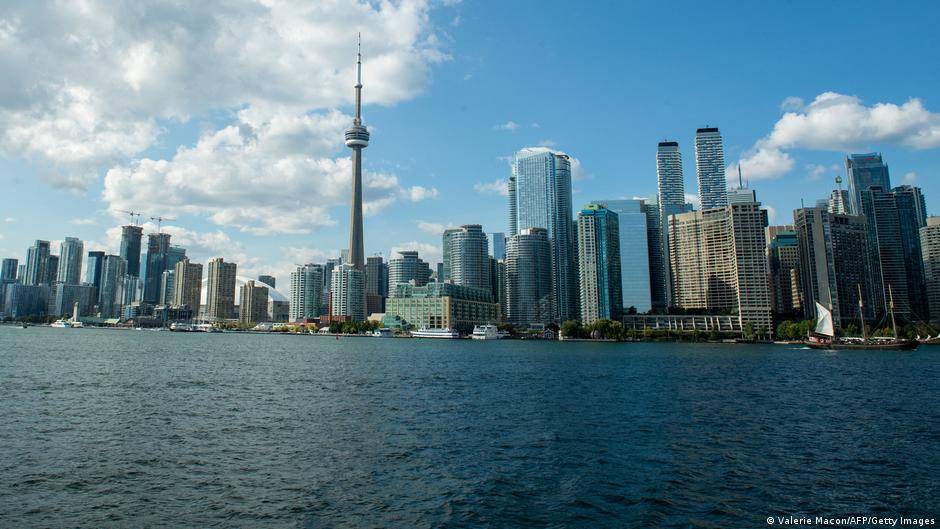“Blame Canada!” goes the satirical song from the 1999 animated comedy film “South Park: Bigger, Longer & Uncut,” where a mother rallies her small Colorado town to confront youth degeneracy.
The song humorously shifts blame to America’s northern neighbor rather than United States government policies, parenting failures, or media influence, declaring, “We need to form a full assault — it’s Canada’s fault.”
Decades later, US President-elect Donald Trump appears to be channeling a similar energy, blaming Canada for illegal migration and drug trafficking across the northern border.
Weeks after winning a second term in the White House, Trump threatened to impose 25% tariffs on all Canadian imports — including cars and automotive parts — starting from his first day in office.
He has since stepped up his rhetoric, joking that Canada could even be annexed as the 51st US state. He even mocked the Canadian Prime Minister Justin Trudeau — who resigned last week amid plummeting approval ratings — by calling him the “Governor” of the “Great State of Canada.”
Trump bombast or threat to be tackled?
While some analysts believe the rhetoric is typical Trump bluster, his remarks have been widely condemned by Canadian politicians and economists as Canada wasn’t a major target for the Republican candidate during the US election campaign — unlike China, Mexico, BRICS and NATO.
“It came like a bolt from the blue,” Douglas Porter, chief economist of the Bank of Montreal (BMO), told DW, referring to Trump’s attack. “There was no groundswell among his supporters that saw Canada as a big villain … so I find this one a bit more unnerving.”
Porter said Trump’s reasoning appears to be changing as he prepares to take office on January 20.
“Initially, there were concerns about the border, which I think Canada would be happy to address. Then there was talk about the US-Canada trade imbalance. And in his press conference the other day, Trump talked about imposing economic hardship on Canada,” he said.
Despite championing and signing the United States-Mexico-Canada Agreement (USMCA), which took effect in 2020, Trump now says Washington‘s neighbors have failed to meet key terms in the accord, from border control to trade. The deal is up for review next year.
Trump “is known to rip up his own deals to secure even better deals,” Tony Stillo, Director of Canada Economics at the economic advisory firm Oxford Economics, told DW. “Even though he helped negotiate the USMCA that replaced NAFTA (North American Free Trade Agreement), he’s now calling it the worst deal ever.”
The US does, however, have far worse trade imbalances with China, Mexico, Vietnam, Germany, and Japan than with Canada, which was nearly $55 billion (€53.6 billion) last year, according to the US Census Bureau.
By comparison, the US-China trade imbalance was almost five times higher, at $270.4 billion. The US-Canada trade imbalance has fallen by nearly 30% over the past two years. However, it was much lower before the pandemic and the USMCA took effect.
Canada getting US subsidy, says Trump
Trump wrote on his Truth Social messaging platform this week that the imbalance is effectively a US subsidy to Canada, saying the world’s largest economy “can no longer suffer the massive Trade Deficits that Canada needs to stay afloat.”
US-Canada trade is one of the most extensive and integrated partnerships in the world. Last year, $699.4 billion of trade was conducted. Canada is the largest market for US exports, ahead of Mexico, Europe and China. US exports include trucks, vans, cars and auto parts as well as fossil fuels.
The US is also Canada’s top export destination, with more than three-quarters of outbound Canadian goods and services heading across the southern border. For comparison, 53% of Germany’s exports go to other European Union nations.
Crude oil makes up a quarter of Canada’s exports southward, which in July 2024 reached a record 4.3 million barrels per day, according to the US Energy Information Administration (EIA).
Thanks to surplus US processing capacity, the US refines the crude oil into gasoline, diesel, and jet fuel for domestic use and re-export — some of it back to Canada.
Trouble for oil and auto sectors
Danielle Smith, the premier of the oil-rich Canadian province of Alberta, warned the US would be shooting itself in the foot if Trump makes good on his threats, writing this week on X that: “Any proposed tariffs would immediately hurt American refiners and also make consumers pay more at the pumps.”
Trump’s ire has also targeted Canada’s automotive industry, which the president-elect says has shifted manufacturing across the northern border in recent years, resulting in layoffs for American workers.
However, North America’s auto sector is deeply integrated and parts and vehicles often cross the US-Canada border multiple times during production.
Canadian auto executives have warned that tariffs could disrupt complex supply chains, leading to increased costs and inefficiencies — spiking prices for new vehicles in both countries.
“If you tariff at 25% every time it [an auto part] goes across a border, the costs become ridiculous,” William Huggins, assistant professor at McMaster University’s DeGroote School of Business, told DW.
Canada’s BNN Bloomberg this week cited economists as saying the US tariffs could shrink Canada’s gross domestic product (GDP) by 2-4% and may tip the economy into recession.
Ottowa readies tit-for-tat measures
Canada’s ruling Liberal Party won’t elect Trudeau’s successor until March 9. While his departure leaves his country politically rudderless, Canadian policymakers have devised a list of US imports that might face retaliation if Trump proceeds with his tariff plan.
The Global & Mail newspaper reported this week that Ottowa is considering tariffs on US steel, ceramics, glass, flowers and Florida orange juice, among other goods.
“They [The Canadian side] have only identified a handful of sectors because they don’t want to put everything on the table yet to undermine their negotiating position,” Stillo said.
But with mostly bluster and outlandish threats to go on, Canada’s leaders are yet to know exactly what Trump is seeking. Are his tariff threats a negotiating tactic to improve border control, boost energy and automotive cooperation or hike Canada’s contributions to NATO?
“We’re not dealing with an enlightened multi-step US policy,” Huggins said. “We’re dealing with a bully who said, ‘Give me your lunch money,’ so we’re probably going to give them the change in our pockets.”
But despite the short-term disruption to both nations’ economies, the McMaster University economist thinks policymakers in Ottowa will look to play the long game, for one obvious reason.
“30 years from now, Donald Trump won’t be alive, but Canada will be,” Huggins told DW.
Edited by: Uwe Hessler
America’s 51st state? How Canada might take on Trump – DW – 01/10/2025


